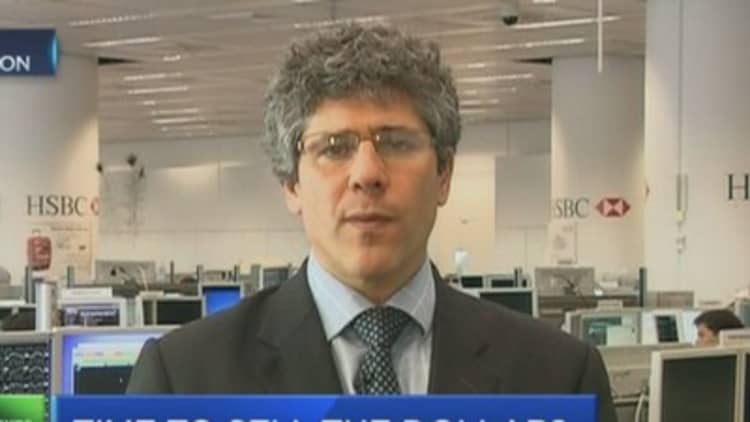
The euro is seen clocking up its biggest quarterly decline at the end of March since its launch in 1999—and could fall even further over the coming months.
The currency, which is used by the 19 countries in the euro zone, continued to decline on Tuesday, reaching $1.0718. It has fallen over 11 percent against the U.S. dollar since the start of the year, putting it on track for its steepest-ever quarterly decline.
The currency's losses have been driven by the launch of the European Central (ECB)'s 1 trillion euro ($1.1 trillion) quantitative easing program in March. Asset purchases by the ECB increase the supply of euros in the monetary system, pushing the currency's price lower.
Read MoreTrack the euro live with CNBC
But a weaker euro is not necessarily a bad thing. The central bank hopes that by keeping money "cheap" it will spur companies and individuals to spend and borrow more, spurring inflation from record lows. And a lower euro can also provide a boost to the region's exporters, as it makes their products cheaper on the global market.
The euro has also been hit by expectations that the Federal Reserve could soon raise U.S. interest rates from record lows, which have pushed up the dollar.
Given the euro's decline, pundits have been debating if—or when—it could reach parity with the U.S. dollar. This last occurred in 2002, and before that in 1999, at the launch of the euro.
Angus Campbell, senior analyst at FxPro, said there was "every chance" the euro could reach parity by the end of the second quarter this year.
"There is not much going for the euro in all honesty," Campbell told CNBC on Tuesday.
"When you consider what is going against the euro, in terms of money policy by the ECB, sluggish economic growth, high unemployment across many of the euro zone countries. If you compare that to the U.S., where clearly the economy is growing robustly and they are looking to hike interest rates soon… investors are more willing to hold other currencies as opposed to the euro."
'More European woes'
CNBC conducted an online poll last week, asking what might push the euro to parity with the dollar. Some 35 percent of 3,138 respondents thought that "more European woes" would do so, while 37 percent voted for "stronger U.S. data."
This could come in the form of better-than expected official nonfarm jobs data, which are due out of the U.S. on Friday.
The euro rose marginally on Tuesday after euro zone inflation data came in as expected, with price declines easing to 0.1 percent year-on-year in March.
Campbell said that rising inflation was an upside risk for the euro—but not one that was his base case scenario.
"The upside scenario is relatively limited. If you do see inflation start to show that is coming back quicker than expected, then you could see a return towards $1.15 relatively quickly, and in the case of a move above there, than you've got to be fancying $1.20."
The decline in first quarter 2015 will be the euro's fourth successive quarter of declines against the dollar. The currency has also fallen by around 6.5 percent against sterling this year and 13 percent against the Swiss franc.
Prior to this year, the euro's worst quarter was between July and September of 2008, at the height of the global financial crisis, when it fell by 10.49 percent against the dollar.
Having breached $1.0752, ADS Securities said on Tuesday that the next downside targets for the euro were $1.0613 and $1.0582.
Read MoreMissed the rally? Europe's best stocks this quarter
Correction: This piece has been updated to reflect that 1 trillion euros equals around $1.1 trillion.

